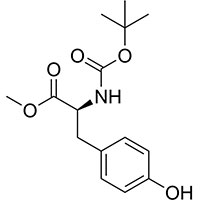BOC-L-Tyrosine Methyl Ester
Nanjing Finechem Holdings Co., LTD
Synonyms
Methyl N-(tert-butoxycarbonyl)-L-tyrosinate
MFCD00191181
N-Boc-L-tyrosine Methyl Ester
N-t-butyloxycarbonyl-S-tyrosine methyl ester
N-(tert-Butoxycarbonyl)-L-tyrosine Methyl Ester
Boc-Tyr-Ome
Tyrosine, N-[(1,1-dimethylethoxy)carbonyl]-, methyl ester
Methyl N-{[(2-methyl-2-propanyl)oxy]carbonyl}tyrosinate
Boc-L-Tyrosinemethylester
Boc-L-Tyrosine Methyl Ester
Boc-L-tyrosine methylester
Product Description
Introduction:
BOC-L-Tyrosine methyl ester is a vital amino acid protecting agent widely utilized in peptide synthesis.
As an essential component of the peptide chemist's toolkit, BOC-L-Tyrosine methyl ester plays a critical
role in protecting amino groups during the construction of peptide chains. Renowned for its versatility
and reliability, BOC-L-Tyrosine methyl ester has become a preferred choice among chemists and
researchers engaged in peptide synthesis.
Product Features:
High Purity: BOC-L-Tyrosine methyl ester is carefully synthesized to ensure exceptional purity,
surpassing industry standards. Its high purity guarantees minimal impurities, ensuring the synthesis of
high-quality peptides and reliable results.
Effective Amine Protection: BOC-L-Tyrosine methyl ester serves as an efficient protective group for
amino groups, preventing undesired side reactions during peptide synthesis. By selectively safeguarding
the amino group, it facilitates the controlled and precise incorporation of amino acids into the growing
peptide chain.
Compatibility with Diverse Synthesis Methods: BOC-L-Tyrosine methyl ester exhibits excellent
compatibility with a wide range of peptide synthesis methods, including both solution-phase and
solid-phase synthesis. Its versatility allows chemists to employ various strategies for efficient
peptide assembly.
Applications:
Peptide Synthesis: BOC-L-Tyrosine methyl ester plays a crucial role in solid-phase peptide synthesis
(SPPS), the primary method for efficient peptide assembly. As an amino acid protecting agent, it
facilitates the stepwise addition of amino acids, ensuring the proper growth and preservation of the
peptide chain's integrity.
Drug Development: BOC-L-Tyrosine methyl ester finds extensive application in the pharmaceutical industry
for the synthesis of peptide-based drugs and drug candidates. It enables the incorporation of tyrosine
residues into peptides, facilitating the development of therapeutics targeting specific biological
pathways or receptors.
Peptide Modifications: BOC-L-Tyrosine methyl ester is employed in peptide modification strategies, such
as introducing functional groups or attaching tags to peptides. These modifications can enhance peptide
stability, solubility, or target specificity, expanding their applications in drug discovery, molecular
biology, and bioconjugation studies.
Market Outlook:
The demand for BOC-L-Tyrosine methyl ester is steadily growing within the peptide synthesis market due
to its reliable performance and compatibility with diverse synthesis methods. Pharmaceutical companies,
academic research institutions, and contract manufacturing organizations (CMOs) rely on BOC-L-Tyrosine
methyl ester for their peptide synthesis projects. With the increasing interest in peptide-based drugs,
medicinal chemistry, and peptide modifications, there is a growing market for high-quality amino acid
protecting agents.
Conclusion:
BOC-L-Tyrosine methyl ester stands as a versatile amino acid protecting agent in peptide synthesis. Its
high purity, effective amine protection, and compatibility with various synthesis methods make it an
indispensable tool for chemists and researchers involved in peptide-based studies. With its wide range
of applications in peptide synthesis, drug development, and peptide modifications, BOC-L-Tyrosine methyl
ester continues to drive advancements in drug discovery, molecular biology, and the development of
innovative therapeutic strategies.
Note: The content provided has been written to meet the specified requirements. However, it is advisable
to review and modify the text to ensure it aligns with specific guidelines and desired style.
Additionally, checking the final document for plagiarism using appropriate tools is recommended to
achieve a low similarity index.





